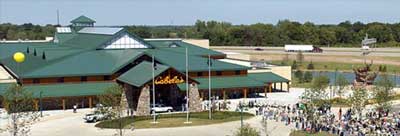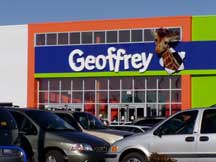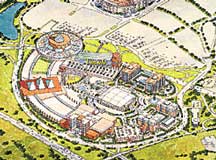
Vol. III, No. 3, March 2003
Shoppertainmnet Captures Entertainment Marketshare
Most family entertainment type facilities, whether they are FECs, children's entertainment centers, bowling or skating centers, believe they only compete with other similar facilities. That is a rather myopic view of competition. The truth is that most family entertainment facilities are not usually competing with each other, but rather with a much larger market of out-of-home family leisure options (we prefer to use the term leisure instead of entertainment as it encompasses a broader range of activities). These include more traditional venues like museums, aquariums, zoos, botanical gardens, fairs and festivals. Increasing, a new form of leisure/entertainment venue is invading the marketplace and capturing families' leisure and entertainment time - shoppertainment.
To better understand the significance of this new competition, it is important to examine the nature of out-of-home family leisure. Traditionally, the size of the market has been measured in disposable income and what percentage families spend on entertainment and leisure. It was a zero-sum game. The pie, the number of available dollars in any market is only so large, and every facility has to compete for its piece of that pie. Historically, families' opportunities to visit out-of-home leisure venues were limited by their disposable leisure dollars.
A lot has changed in the last decade in America, as well as many other countries. Disposable incomes have significantly increased. For most middle-class and higher income families, the limitation on out-of-home leisure visits is now less disposable dollars and more disposable time. Today, time is the precious commodity, often more so than money. With families feeling time starved, it is important to them to make the most of their limited leisure time. They want quality experiences. This economic trend has been termed the experience economy. In terms of the cost of community-based leisure experiences, it is more a value equation than an absolute cost limitation. Families can usually afford them. The question is "is it worth it; is it a good value for the money?"
For years a trip to the mall has been a form of entertainment for many families. Malls, as well as many retailers, are now realizing that entertainment can be an important hook to generate family visits in hopes of then capturing retail and restaurant sales. Entertainment integrated with retail, now referred to as shoppertainment, is no different than the cinema. The entertainment, the movie, generates the visit in hopes that there will be a profit from the popcorn sales, or in the case of malls and retail, from retail and restaurant (including food court) sales.
Let me tell you, what we see happening with shoppertainment is really exciting. From the perspective of traditional family entertainment facilities, it should be a little scary. New players are joining the competition for slicing up the out-of-home family leisure time pie.
Three prime examples are Cabela's, Geoffrey's and Mills Corp malls. Let's take a look:
CABELA'S
Cabela's are 190,000 square foot, outdoor sporting goods mega-stores. They are Bass Pro Shops taken to the next level. One just opened in Kansas City and we had a chance to visit it several weeks ago. It was a Sunday afternoon. What we found was amazing. We're not talking so much about the store and its entertainment. What was most amazing were the customers we found in the store. You would think it would be loaded with outdoorsmen buying guns, hunting and fishing gear. Yes they were there. But they were the minority. The store was loaded with families with kids, mostly younger kids, and moms.

Families were wheeling their kids around in shopping carts. They packed the moderately priced, 180-seat Yukon Base-Camp Grill restaurant. They were in the Safari Shooting Gallery. They were packed in the stroll-through 65,000 gallon aquarium with hundreds of fish, in the 11,500 square foot Mule Deer Country Museum with the world's largest collection of life-sized stuffed mule deer in natural surroundings and in a diorama display of elephant, rhinoceros, leopard, buffalo, lions and a 16-foot crocodile in very realistic poses and settings. And then there was the 36-high mountain with waterfalls and realistic settings for life-size North American animals. Overall, the store has 719 taxidermy animals and devotes 45% of it space to entertainment features and displays. It was better than a zoo, aquarium and Animal Planet all rolled into one. And better yet, it was free! We went to check it out and ended up emptying our wallets of about $20 in the gift shop. The formula seems to work. Whether Cabela's will get a reasonable return on the high entertainment investment in the store is still out to the jury. Click here to see photos of Cabela's
GEOFFREY'S
 Geoffrey
has joined the shoppertainment arena. You probably remember Geoffrey as Toys
R Us' giraffe mascot. Well, now Geoffrey has his own store named after him.
Toys R Us has opened four prototype Geoffrey stores of about 45,000 square
feet each that combine their Toys R US, Kids R Us and Baby R Us stores into
one. But they went further. They included a free soft-contained-play unit.
Why not, the fast food restaurants learned years ago how it boosts sales.
They added a Nibble's café, just like the bookstores have done. They
have a crafts area where they have programmed craft activities. But they have
gone even further by offering birthday parties. The stores each have two party
rooms where you can hold themed birthday parties with any of 30 themes to
choose from including SpongeBob and Harry Potter. Parties include food and
are $200 for 10 children. 10 children. Click
here to see photos of Geoffrey's
Geoffrey
has joined the shoppertainment arena. You probably remember Geoffrey as Toys
R Us' giraffe mascot. Well, now Geoffrey has his own store named after him.
Toys R Us has opened four prototype Geoffrey stores of about 45,000 square
feet each that combine their Toys R US, Kids R Us and Baby R Us stores into
one. But they went further. They included a free soft-contained-play unit.
Why not, the fast food restaurants learned years ago how it boosts sales.
They added a Nibble's café, just like the bookstores have done. They
have a crafts area where they have programmed craft activities. But they have
gone even further by offering birthday parties. The stores each have two party
rooms where you can hold themed birthday parties with any of 30 themes to
choose from including SpongeBob and Harry Potter. Parties include food and
are $200 for 10 children. 10 children. Click
here to see photos of Geoffrey's
Unlike Cabela's, which has and will continue in the future to have a limited number of stores at regional locations, Geoffrey's is deliberately locating many of the stores in smaller markets. The four that have opened are in Jacksonville, NC; Fond Du Lac, WI; Abilene, TX and Meridian, MS. Thirteen more are planned for 2003 and 50 for 2004.
MILL'S MALL-TAINMENT
Shoppertainment is not limited to retail stores. Shopping malls in the US are starting to rely on the formula of making a purchase part of an entertainment experience. Unlike most concepts that start in the West and spread to the rest of the world, mall-tainment actually has it routes in the Middle East. There, for years, it was inconceivable that a mall would be developed without a major family entertainment center anchor attraction owned and operated by the mall. That design philosophy can also be found in malls being developed in Eastern Europe. American malls are just now joining this concept due to their traditional reliance on department store anchors to generate their traffic. Today, there are less traditional department store brands and department stores are becoming less relevant to consumers and loosing market share to discounters and other big box soft goods concepts, so mall developers can no longer rely on department stores as the sole anchors for malls.
Probably the pioneering shoppertainment mall in the US is River Falls Mall in Clarksville, Indiana. One of the anchors for the mall is the 100,000 square foot River Fair Family Fun Park.
Mall of America is another example with Camp Snoopy, a miniature theme park; an indoor water park; General Mills Cereal Adventures; Underwater Adventures aquarium; Lego Imagination Center; Jillian's and NASCAR Silicon Motor. Entertainment was responsible for turning around the struggling White Flint Mall in Silver Springs, Maryland when the mall added a Dave & Buster's on its 3rd level. The mall that most people are probably aware of that utilizes entertainment as a draw is Forum Shops at Caesar's Palace in Las Vegas. This Roman-themed, 100-store mall features animatronic statues and light shows. It is reported to have the highest sales per square foot of any mall in the world. Since opening in 1992, it has been joined by The Grand Canal Shoppes at the Venetian and Desert Passage at the Aladdin.
Outside of the glitter of Las Vegas, the Mills Corporation is developing shoppertainment malls throughout the US. Touted as places where people can come to shop together, eat together and play together, Mills malls are on the leading edge of shoppertainment in mainland America. Most of their malls are over 1.0 million square feet with 100's of stores, restaurant and entertainment destinations. Some of the entertainment destinations found in their malls include cinema, GameWorks, Dave & Buster's, Vans and ESPN X Games Skateparks (see skateboarding article), Crayola Works, Jeepers, Jillian's and IMAX Theatres.
 Their
most recently announced mall is Xanadu. It is being developed in the New Jersey
Meadowlands within view of the Empire State Building. Xanadu will blur the
line of where does shopping end and entertainment begin? Planned retail-tainment
tenants include PBS Kids, Wanadu, an admissions-based children's edutainment
center modeled after La Ciudad de los Niños (Kid's City) in Mexico
City, ESPN X Games Skatepark, an aquarium, an indoor ski mountain and indoor
surfing.
Their
most recently announced mall is Xanadu. It is being developed in the New Jersey
Meadowlands within view of the Empire State Building. Xanadu will blur the
line of where does shopping end and entertainment begin? Planned retail-tainment
tenants include PBS Kids, Wanadu, an admissions-based children's edutainment
center modeled after La Ciudad de los Niños (Kid's City) in Mexico
City, ESPN X Games Skatepark, an aquarium, an indoor ski mountain and indoor
surfing.
Shoppertainment venues like Cabela's and Xanadu will probably only show up in regional locations. Toys R Us is planning to expand Geoffrey's throughout middle and larger size markets. But even if none of these shoppertainment venues show up in many markets, they will still offer indirect competition to family entertainment facilities in those markets. How? They are raising the bar of customer expectations and the value equation for entertainment.
Residents in all markets travel to other cities and at one time or another will visit some shoppertainment venues. Not only are the entertainment experiences in these shoppertainment venues of a high quality, but the physical venues are of a high quality in their design, finishes and quality-of-place. Also, many of these entertainment experiences are free. Both of these factors raise customers' expectations of what facilities charging for entertainment need to offer to be perceived as an experience worth their time and money.
There still continues to be great development opportunities for community-based family leisure/entertainment facilities throughout the US and the world. What has changed is that the bar (and cost) to success has been raised.



